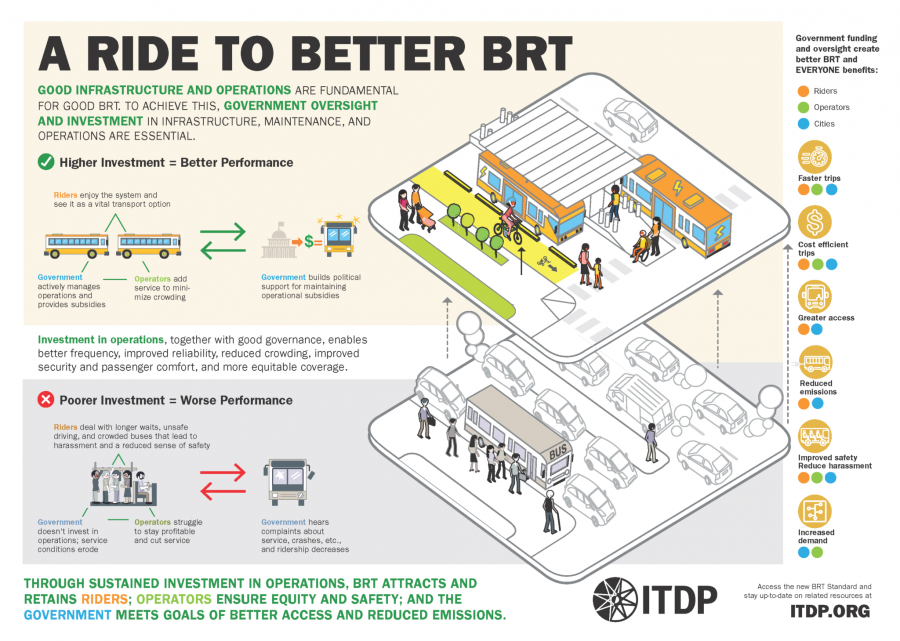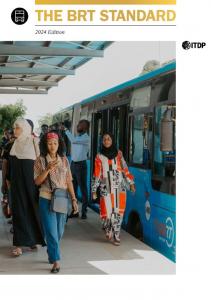
2024 BRT Standard Puts Urgent Spotlight on Climate Resilience, Gender Equity, Accessibility, and Operations
The updated Standard is the right tool for our times, offering a critical framework for the future of not just BRT but good public transport systems everywhere.
NEW YORK, NEW YORK, UNITED STATES, April 24, 2024 /EINPresswire.com/ -- The Institute for Transportation and Development Policy (ITDP) released the first comprehensive update to The BRT Standard since 2016, updating its defining and scoring designation for bus rapid transit (BRT) systems around the world. First launched in 2012, the Standard continues to serve as both a framework for understanding BRT and an evaluation tool for corridors based on international best practices. Similar to the LEED designation for green buildings, BRT corridors may achieve a basic, bronze, silver or gold designation based on the criteria set forth in the Standard.
Over 153 BRT corridors have opened in 91 cities in 24 countries in the past decade and BRT is a much more familiar concept for cities and the public today. Thus, following increasingly severe climate events and the impacts of the COVID-19 pandemic, a number of challenges and considerations have arisen in recent years that warranted a refresh of the Standard. The 2024 update provides a transport tool for these times, better reflecting the evolving and complex needs of our cities, our public transport systems, and everyday users. With the guidance and review of global BRT and mobility experts, this edition incorporates:
+ An Expanded Focus on Gender, Safety, and Access: A number of elements have been amended or added to better address issues around access and safety. A higher level of importance of access for persons with disabilities, women, and caregivers is reflected through amendments to elements like Customer-Friendly Stations and Passenger Communications.
+ More Attention to Climate, Greening Measures and Resiliency: New elements highlight the ways in which BRT systems can improve community emergency preparedness, address climate change, improve air quality, and enhance people’s well-being and public health. Vehicle electrification is also noted as the best way to reduce emissions.
+ An Improved Focus on Passenger and Customer Experience: A number of elements have been modified to address the passenger experience.
+ Deductions for Overcrowding, Long Signals, and Bus Bunching: Negative points in BRT system scoring were significantly increased to recognize the impact that poor operations have on service quality and ridership.
+ A New Focus on Business Operations: The business model that undergirds the system and provides the conditions for service delivery is fundamental to BRT. Therefore, a Business Model element has been added to encourage high-quality operations.
As BRT corridors continue to be planned around the world, these systems have significant potential to continue delivering fast, reliable, safe, and quality transport services to all urban populations at a relatively low-cost to cities and governments. Most critically, the success of quality BRT systems can help cities deliver on people-oriented mobility that is more inclusive and equitable, while also encouraging transit-oriented development policies that support local economies and significantly reduce greenhouse gas emissions.
This year’s updates were formulated into concrete proposals and evaluated by the BRT Standard Technical Committee, a group of leading BRT engineers, designers, and planners that served as a consistent source of sound technical advice and is the basis for establishing the credibility of the Standard. In addition, the Committee is complemented by the Standard’s Institutional Endorsers—including globally recognized organizations like ICLEI, Local Governments for Sustainability and the Transformative Urban Mobility Initiative (TUMI). The Endorsers are an integrated group of highly respected institutions in urban development, public transport, and climate change. Learn more about these individuals and organizations at BRTStandard.org.
In addition to this new edition of the Standard, ITDP will be releasing a number of supporting public transport resources in the coming months to support transport planners, researchers, policymakers, and beyond. This includes a Simplified Calculator of Project Emissions (SCOPE) tool for BRT systems, a series of technical webinars on BRT, an ITDP Learning Hub course, and other engaging content. Visit ITDP.org for the latest updates.
“The updated guidance in the 2024 BRT Standard recognizes the wide range of benefits and solutions provided by high-quality bus rapid transit systems,” said Nicolas Peltier-Thiberge, Global Director for the Transport Sector at the World Bank. “It also outlines the necessary reforms and conditions cities need to make to ensure successful service and operations.”
“As a practitioner, I find the Standard useful in guiding our counterparts in developing countries on the definition, planning, and implementation of quality BRT projects,” said David Margonsztern, Principal Urban Transport Specialist at Agence Française de Développement (AFD). “The updated scoring is comprehensive and includes all of the important elements of good BRT development. It also provides an incentive to aim for Gold Standard BRT ratings, while allowing flexibility to adjust to local contexts.”
“Improving the efficiency and accessibility of public transport is critical to the future of every city. As the climate crisis worsens, the development of more high-quality, sustainable, and cost-effective BRT corridors can be the mobility solution we need for modern times,” said Heather Thompson, CEO of ITDP. “The 2024 Standard reflects the changing nature of BRT and public infrastructure as a whole, and we know that planners and policymakers alike will benefit from its insights.”
Access the 2024 BRT Standard and resources here.
###
The Institute for Transportation and Development Policy (ITDP) is a global nonprofit that works with cities worldwide to design and implement high-quality transport systems and policy solutions that make cities more livable, equitable, and sustainable. Join the conversation with #ITDPYearoftheBus
Veronica Ortiz
ITDP
+1 212-629-8001
veronica.ortiz@itdp.org
Visit us on social media:
Facebook
Twitter
LinkedIn
Instagram
YouTube
Other
EIN Presswire does not exercise editorial control over third-party content provided, uploaded, published, or distributed by users of EIN Presswire. We are a distributor, not a publisher, of 3rd party content. Such content may contain the views, opinions, statements, offers, and other material of the respective users, suppliers, participants, or authors.




